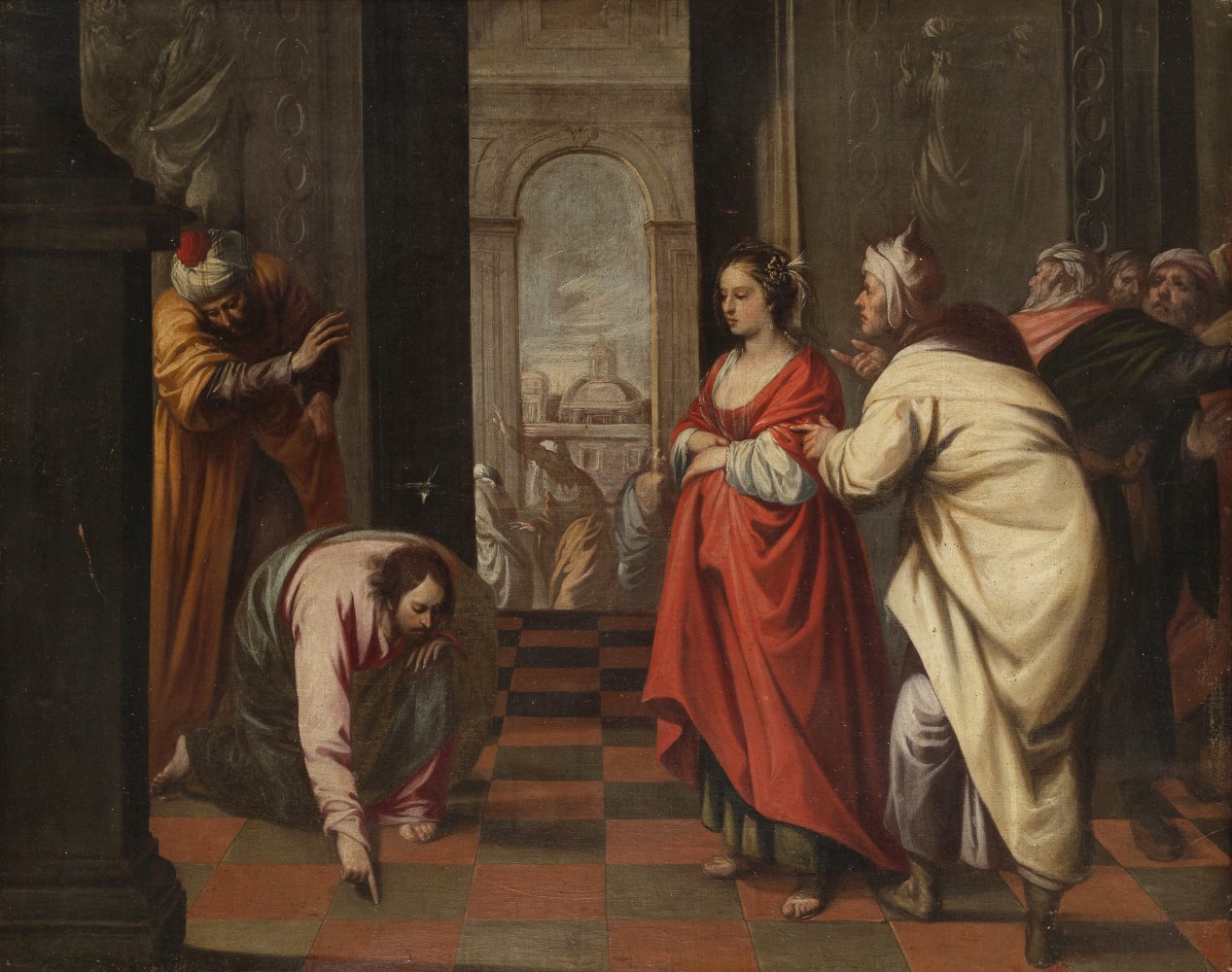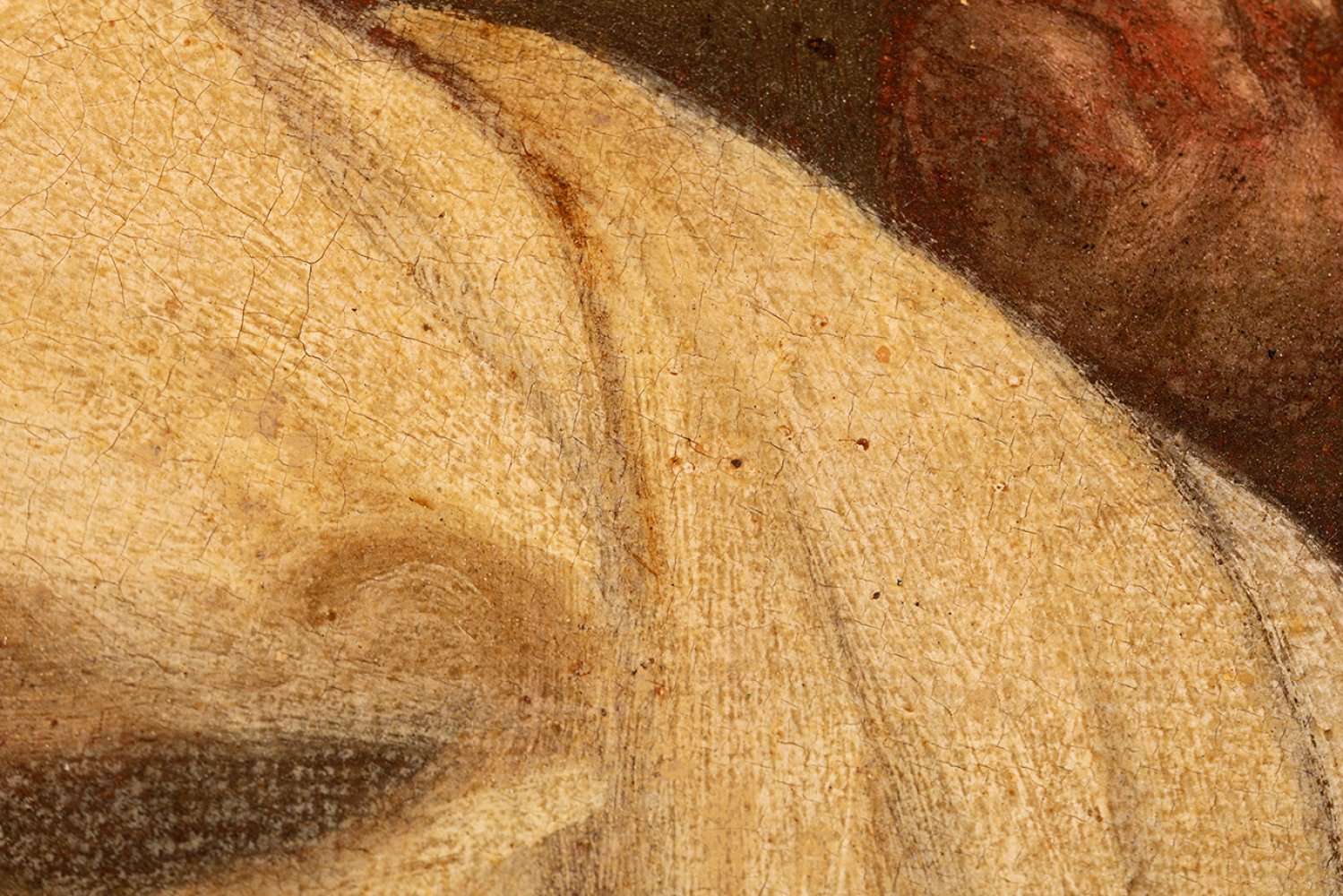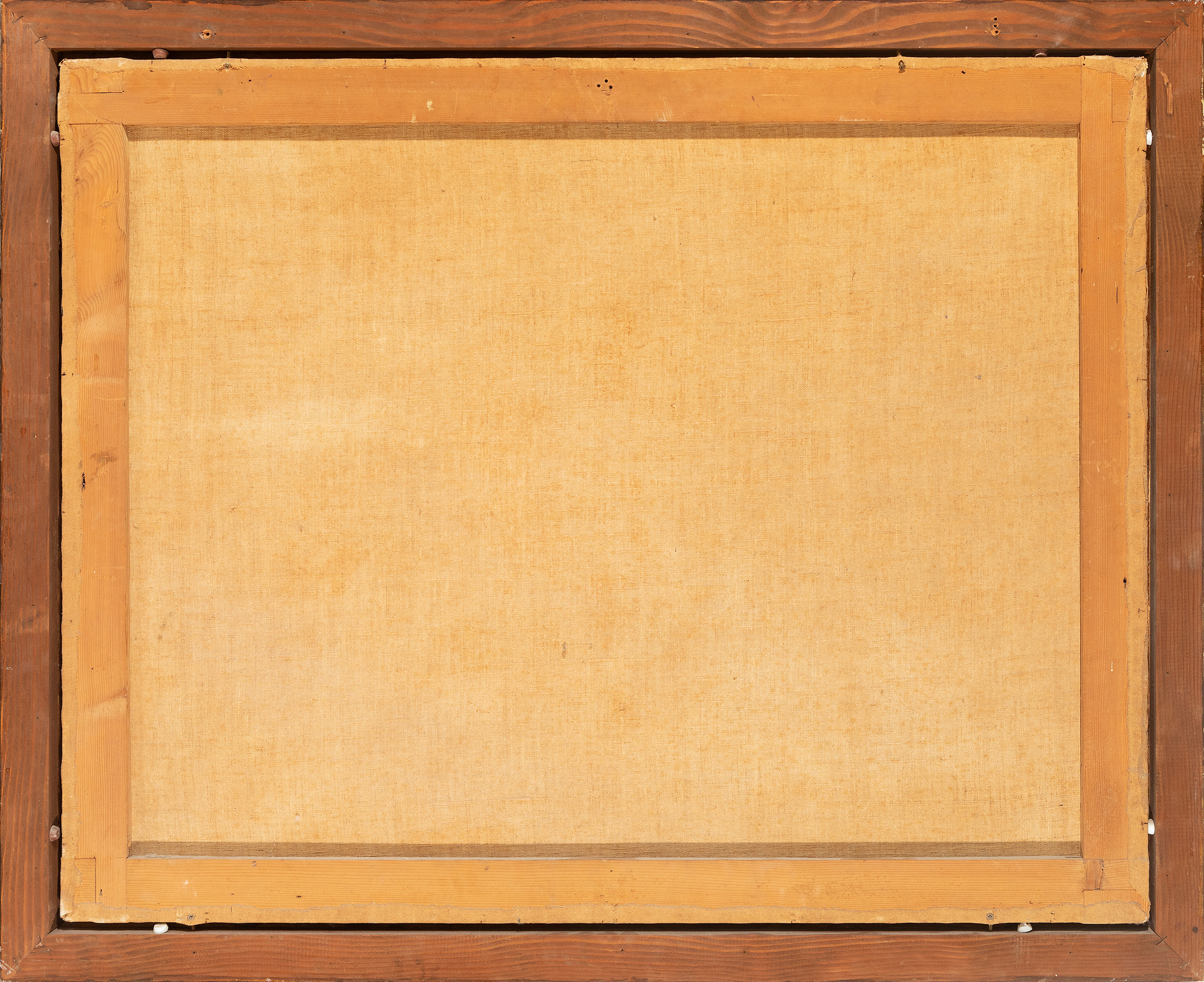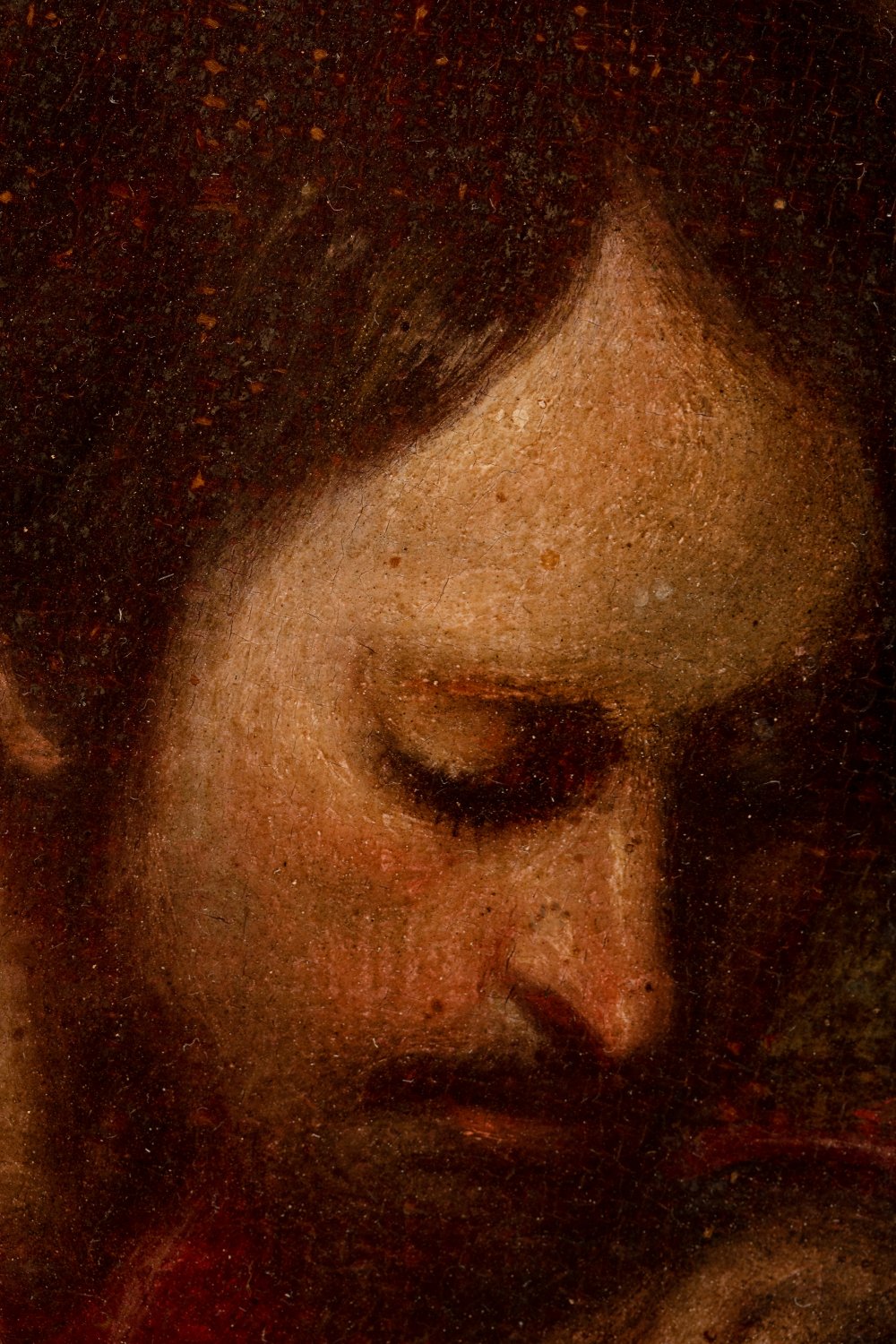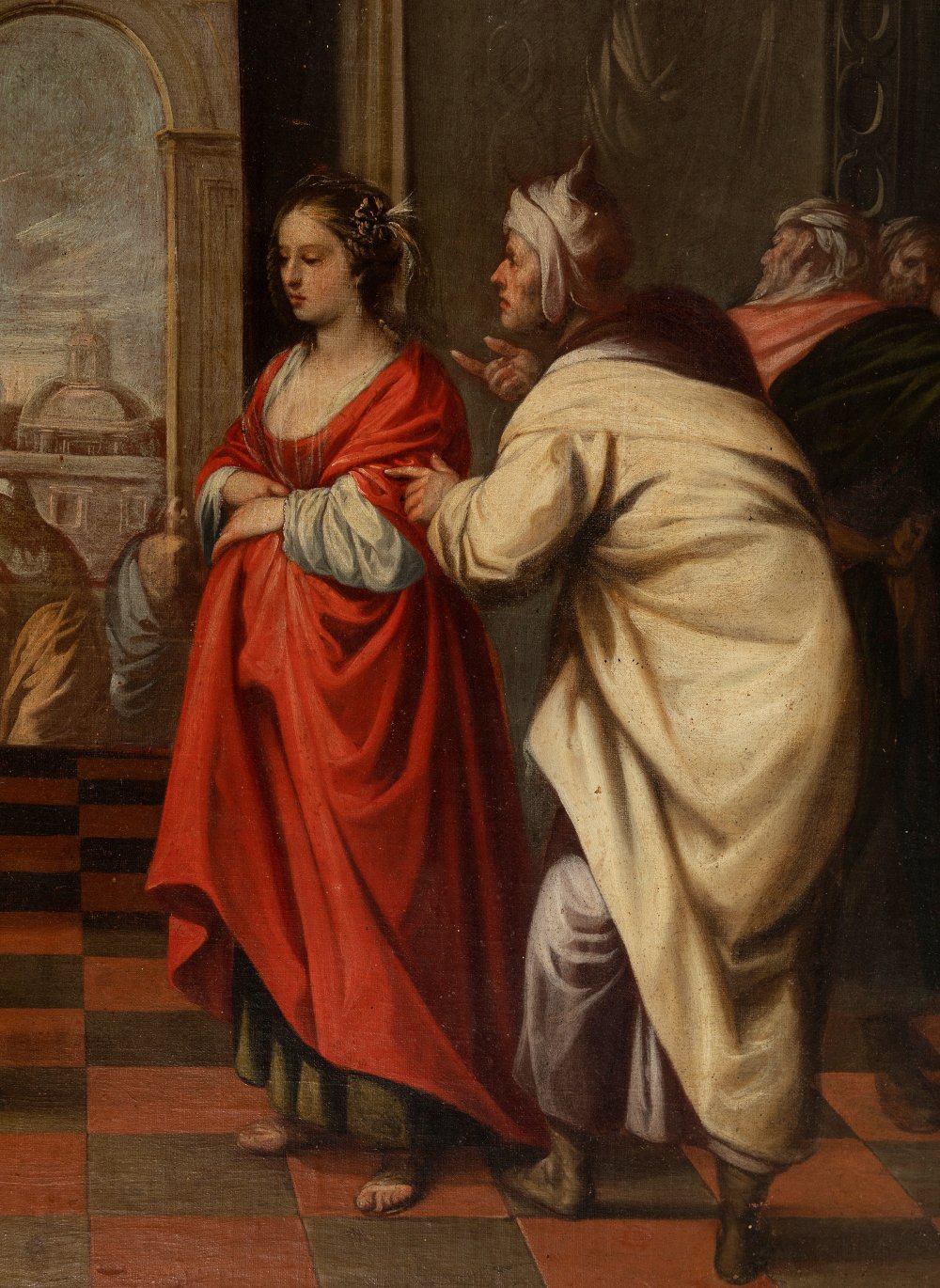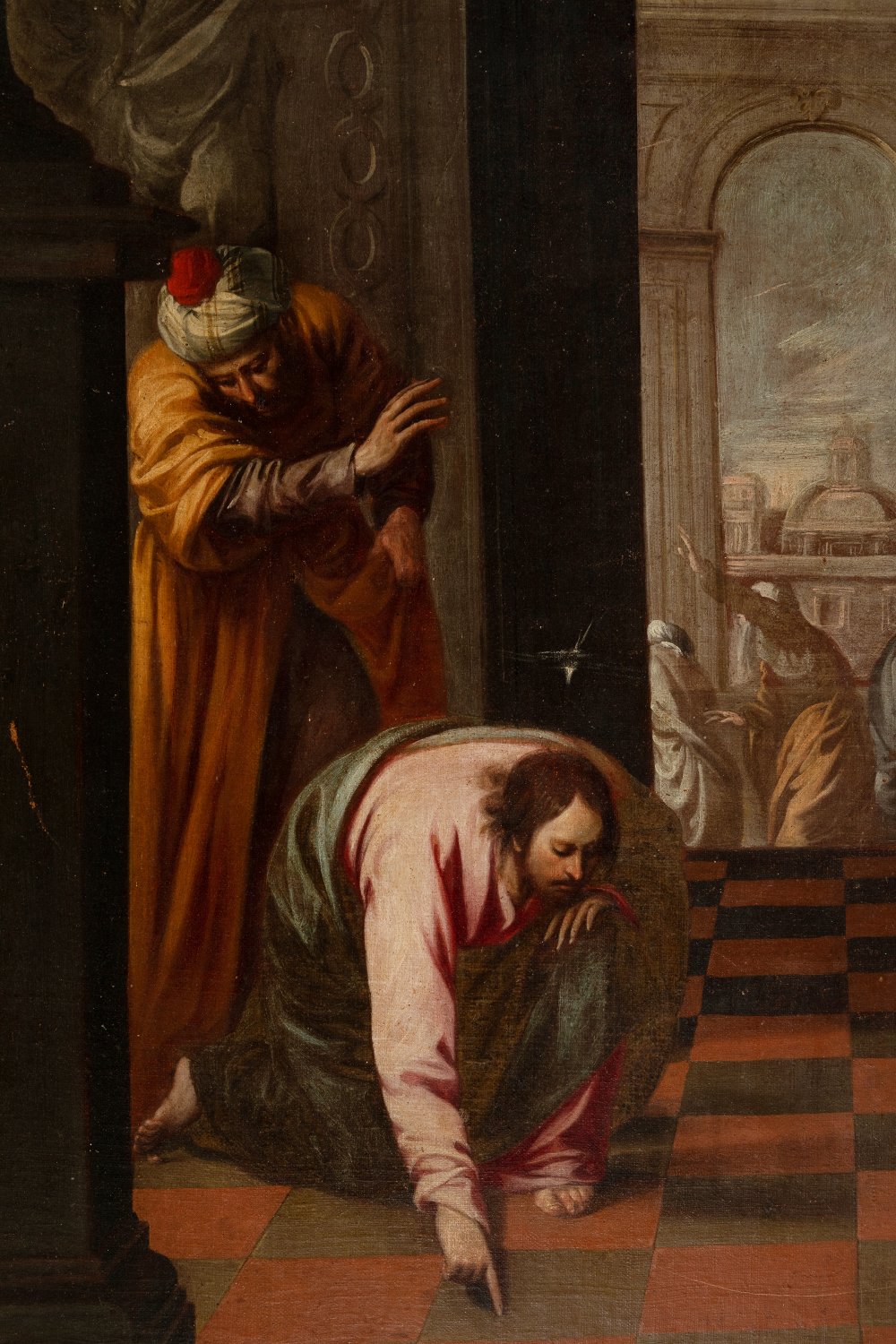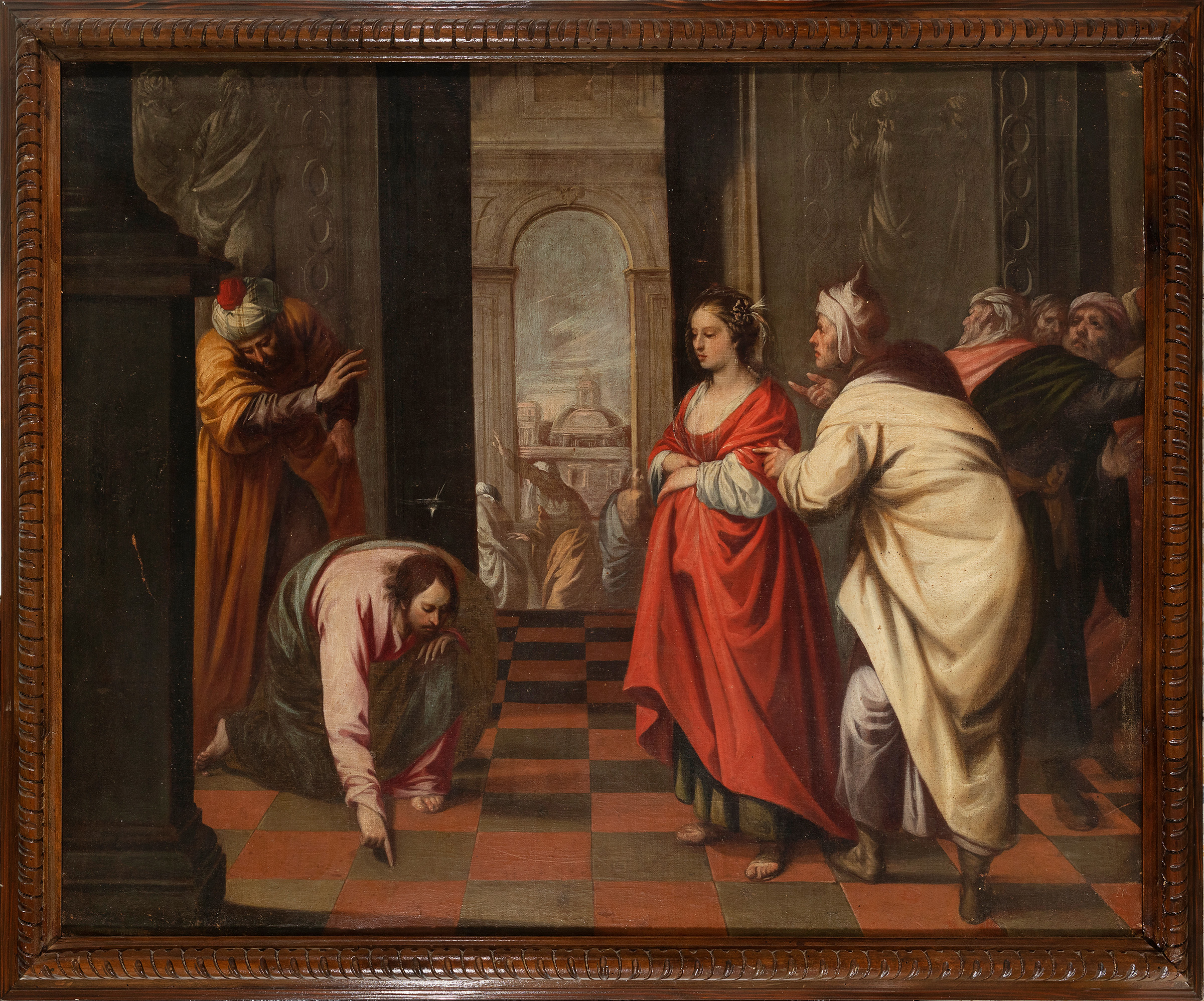36
MATÍAS DE ARTEAGA Y ALFARO (Villanueva de los Infantes, Ciudad Real, 1633 - Seville, 1703)."Jesus
1/7
Description
MATÍAS DE ARTEAGA Y ALFARO (Villanueva de los Infantes, Ciudad Real, 1633 - Seville, 1703).
"Jesus and the adulteress".
Oil on canvas.
Relined.
Measurements: 84 x 105 cm; 95 x 116 cm (frame).
In this oil painting by Matías de Arteaga, as was typical of this painter's art, the architectural interior has been meticulously described and worked following the precepts of Italian perspective. However, Renaissance spatial solutions became more complicated in the Baroque period, with the superimposition of scenes and spaces. The main scene is occupied by Jesus, who points to the ground while saying "Let him who is blameless cast the first stone". In front of him is the woman who was to be stoned for adultery. The other figures are stunned and undecided by his words. The relief effect of the figures carved in the stone, the rich plasticity of the robes and the flesh tones, as well as the solution of the groups escaping towards a background of arcades are remarkable. The work is very similar to works by Matías de Arteaga, in which classical architecture plays an important role, such as the Wedding at Cana, which belongs to the collection of the Museo de Bellas Artes in Seville, or the Marriage of the Virgin, in the collection of the Museo del Prado.
Matías de Arteaga y Alfaro was a Spanish Baroque painter and engraver. A member of the Sevillian school, he was able to capture and interpret the dual influence of Murillo and Valdés Leal with his own personality. The son of the engraver Bartolomé Arteaga, when he was still a child his family moved to Seville, where he trained in his father's studio and in contact with Murillo, whose influence reveals his early work together with that of Valdés Leal, who settled in Seville the same year that Arteaga passed his master painter's examination in 1656. In 1660 he was among the founding members of the celebrated drawing academy promoted by Murillo, among others, of which he served as secretary between then and 1673. In 1664 he joined the Hermandad de la Santa Caridad brotherhood and two years later the Sacramental del Sagrario brotherhood of Seville cathedral, for which he produced a number of works. Around 1680 he is also recorded as working as an appraiser of paintings. He died in 1703, and the inventory of his estate at his death reveals that he lived well off, having a slave and a large, well-furnished house with a medium-sized library containing important books in Latin and Spanish and an engraving studio, as well as over 150 paintings, almost half of which were of religious subjects. Among them were four series of the Life of the Virgin, some of which were expressly said to contain architectural views, such as those in the present work and those in the Museo de Bellas Artes in Seville. The most characteristic feature of his peculiar style is precisely these series of always religious subjects, set in broad landscapes and architectural perspectives taken from prints. Skilful in the creation of these deep, skilfully illuminated perspectives, he was, however, somewhat clumsy in his treatment of the figures and their bodily expressions. Arteaga is represented in the aforementioned Sevillian museum, various Sevillian churches including the cathedral and the Museo Lázaro Galdiano, among others.
"Jesus and the adulteress".
Oil on canvas.
Relined.
Measurements: 84 x 105 cm; 95 x 116 cm (frame).
In this oil painting by Matías de Arteaga, as was typical of this painter's art, the architectural interior has been meticulously described and worked following the precepts of Italian perspective. However, Renaissance spatial solutions became more complicated in the Baroque period, with the superimposition of scenes and spaces. The main scene is occupied by Jesus, who points to the ground while saying "Let him who is blameless cast the first stone". In front of him is the woman who was to be stoned for adultery. The other figures are stunned and undecided by his words. The relief effect of the figures carved in the stone, the rich plasticity of the robes and the flesh tones, as well as the solution of the groups escaping towards a background of arcades are remarkable. The work is very similar to works by Matías de Arteaga, in which classical architecture plays an important role, such as the Wedding at Cana, which belongs to the collection of the Museo de Bellas Artes in Seville, or the Marriage of the Virgin, in the collection of the Museo del Prado.
Matías de Arteaga y Alfaro was a Spanish Baroque painter and engraver. A member of the Sevillian school, he was able to capture and interpret the dual influence of Murillo and Valdés Leal with his own personality. The son of the engraver Bartolomé Arteaga, when he was still a child his family moved to Seville, where he trained in his father's studio and in contact with Murillo, whose influence reveals his early work together with that of Valdés Leal, who settled in Seville the same year that Arteaga passed his master painter's examination in 1656. In 1660 he was among the founding members of the celebrated drawing academy promoted by Murillo, among others, of which he served as secretary between then and 1673. In 1664 he joined the Hermandad de la Santa Caridad brotherhood and two years later the Sacramental del Sagrario brotherhood of Seville cathedral, for which he produced a number of works. Around 1680 he is also recorded as working as an appraiser of paintings. He died in 1703, and the inventory of his estate at his death reveals that he lived well off, having a slave and a large, well-furnished house with a medium-sized library containing important books in Latin and Spanish and an engraving studio, as well as over 150 paintings, almost half of which were of religious subjects. Among them were four series of the Life of the Virgin, some of which were expressly said to contain architectural views, such as those in the present work and those in the Museo de Bellas Artes in Seville. The most characteristic feature of his peculiar style is precisely these series of always religious subjects, set in broad landscapes and architectural perspectives taken from prints. Skilful in the creation of these deep, skilfully illuminated perspectives, he was, however, somewhat clumsy in his treatment of the figures and their bodily expressions. Arteaga is represented in the aforementioned Sevillian museum, various Sevillian churches including the cathedral and the Museo Lázaro Galdiano, among others.
Auction Details
Shipping
T&Cs & Important Info
Ask seller a question
MATÍAS DE ARTEAGA Y ALFARO (Villanueva de los Infantes, Ciudad Real, 1633 - Seville, 1703).
"Jesus and the adulteress".
Oil on canvas.
Relined.
Measurements: 84 x 105 cm; 95 x 116 cm (frame).
In this oil painting by Matías de Arteaga, as was typical of this painter's art, the architectural interior has been meticulously described and worked following the precepts of Italian perspective. However, Renaissance spatial solutions became more complicated in the Baroque period, with the superimposition of scenes and spaces. The main scene is occupied by Jesus, who points to the ground while saying "Let him who is blameless cast the first stone". In front of him is the woman who was to be stoned for adultery. The other figures are stunned and undecided by his words. The relief effect of the figures carved in the stone, the rich plasticity of the robes and the flesh tones, as well as the solution of the groups escaping towards a background of arcades are remarkable. The work is very similar to works by Matías de Arteaga, in which classical architecture plays an important role, such as the Wedding at Cana, which belongs to the collection of the Museo de Bellas Artes in Seville, or the Marriage of the Virgin, in the collection of the Museo del Prado.
Matías de Arteaga y Alfaro was a Spanish Baroque painter and engraver. A member of the Sevillian school, he was able to capture and interpret the dual influence of Murillo and Valdés Leal with his own personality. The son of the engraver Bartolomé Arteaga, when he was still a child his family moved to Seville, where he trained in his father's studio and in contact with Murillo, whose influence reveals his early work together with that of Valdés Leal, who settled in Seville the same year that Arteaga passed his master painter's examination in 1656. In 1660 he was among the founding members of the celebrated drawing academy promoted by Murillo, among others, of which he served as secretary between then and 1673. In 1664 he joined the Hermandad de la Santa Caridad brotherhood and two years later the Sacramental del Sagrario brotherhood of Seville cathedral, for which he produced a number of works. Around 1680 he is also recorded as working as an appraiser of paintings. He died in 1703, and the inventory of his estate at his death reveals that he lived well off, having a slave and a large, well-furnished house with a medium-sized library containing important books in Latin and Spanish and an engraving studio, as well as over 150 paintings, almost half of which were of religious subjects. Among them were four series of the Life of the Virgin, some of which were expressly said to contain architectural views, such as those in the present work and those in the Museo de Bellas Artes in Seville. The most characteristic feature of his peculiar style is precisely these series of always religious subjects, set in broad landscapes and architectural perspectives taken from prints. Skilful in the creation of these deep, skilfully illuminated perspectives, he was, however, somewhat clumsy in his treatment of the figures and their bodily expressions. Arteaga is represented in the aforementioned Sevillian museum, various Sevillian churches including the cathedral and the Museo Lázaro Galdiano, among others.
"Jesus and the adulteress".
Oil on canvas.
Relined.
Measurements: 84 x 105 cm; 95 x 116 cm (frame).
In this oil painting by Matías de Arteaga, as was typical of this painter's art, the architectural interior has been meticulously described and worked following the precepts of Italian perspective. However, Renaissance spatial solutions became more complicated in the Baroque period, with the superimposition of scenes and spaces. The main scene is occupied by Jesus, who points to the ground while saying "Let him who is blameless cast the first stone". In front of him is the woman who was to be stoned for adultery. The other figures are stunned and undecided by his words. The relief effect of the figures carved in the stone, the rich plasticity of the robes and the flesh tones, as well as the solution of the groups escaping towards a background of arcades are remarkable. The work is very similar to works by Matías de Arteaga, in which classical architecture plays an important role, such as the Wedding at Cana, which belongs to the collection of the Museo de Bellas Artes in Seville, or the Marriage of the Virgin, in the collection of the Museo del Prado.
Matías de Arteaga y Alfaro was a Spanish Baroque painter and engraver. A member of the Sevillian school, he was able to capture and interpret the dual influence of Murillo and Valdés Leal with his own personality. The son of the engraver Bartolomé Arteaga, when he was still a child his family moved to Seville, where he trained in his father's studio and in contact with Murillo, whose influence reveals his early work together with that of Valdés Leal, who settled in Seville the same year that Arteaga passed his master painter's examination in 1656. In 1660 he was among the founding members of the celebrated drawing academy promoted by Murillo, among others, of which he served as secretary between then and 1673. In 1664 he joined the Hermandad de la Santa Caridad brotherhood and two years later the Sacramental del Sagrario brotherhood of Seville cathedral, for which he produced a number of works. Around 1680 he is also recorded as working as an appraiser of paintings. He died in 1703, and the inventory of his estate at his death reveals that he lived well off, having a slave and a large, well-furnished house with a medium-sized library containing important books in Latin and Spanish and an engraving studio, as well as over 150 paintings, almost half of which were of religious subjects. Among them were four series of the Life of the Virgin, some of which were expressly said to contain architectural views, such as those in the present work and those in the Museo de Bellas Artes in Seville. The most characteristic feature of his peculiar style is precisely these series of always religious subjects, set in broad landscapes and architectural perspectives taken from prints. Skilful in the creation of these deep, skilfully illuminated perspectives, he was, however, somewhat clumsy in his treatment of the figures and their bodily expressions. Arteaga is represented in the aforementioned Sevillian museum, various Sevillian churches including the cathedral and the Museo Lázaro Galdiano, among others.
29th December - Old Masters
Sale Date(s)
Venue Address
Aragón 346, Barcelona
Calle Velázquez 7, Madrid
Carrer de Cirilo Amorós 55, Valencia
Barcelona
08009
Spain
General delivery information available from the auctioneer
Setdart offers Worldwide shipping
PICK UP IN ROOM: You can come and pick up your lots in our offices (Barcelona, Madrid or Valencia). At the moment of the withdrawal, you will be able to accept the current conditions of the lot by means of a document that you will sign.
YOU CAN SEND ANOTHER PERSON TO PICK UP: This person must present a signed authorization that you can find in our web page by accessing from BUY AT SETDART- LOGISTICS-DOWNLOAD AUTHORIZATION DOCUMENT. You can also send an e-mail with the requested data in AUTHORIZATION DOCUMENT to admin@setdart.com
Important Information
25% buyer´s premium
21% buyer´s premium at www.setdart.com















